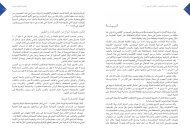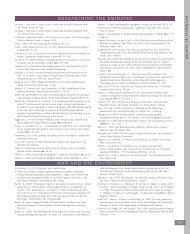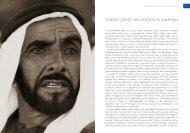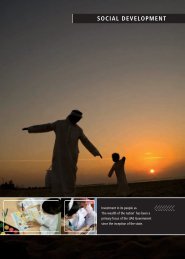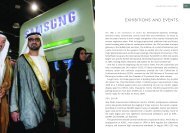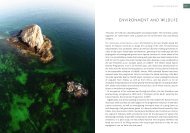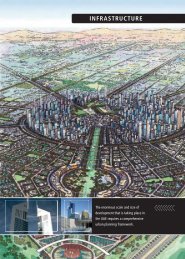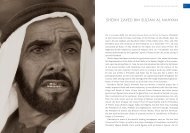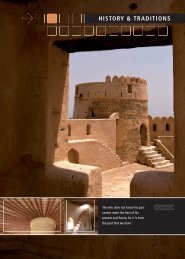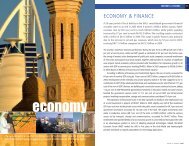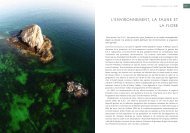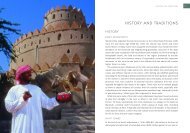Create successful ePaper yourself
Turn your PDF publications into a flip-book with our unique Google optimized e-Paper software.
102UNITED ARAB EMIRATES YEARBOOK 2006<strong>ECONOMIC</strong> <strong>DEVELOPMENT</strong>103different sectors, including automotive, healthcare, construction, IT, food andbeverage, and tourism. Use of the Internet among procurement agencies is rapidlyincreasing with 17 per cent of organisations within the Gulf Cooperation Council(GCC) states engaged in online procurement. The average GCC resident purchasesUS$1068 worth of goods and services online annually, compared to per capitapurchase figures of US$1314 in the United States of America, US$1072 in the UK,and US$875 in Germany.Other active e-marketing operations are www.<strong>UAE</strong>mall.com, which is especiallypopular for buying and selling second-hand cars and works by introducing buyersand sellers rather than direct selling, and a number of share-trading providerssuch as EMAAR Financial Services, which has teamed up with Amlak FinancePJSC to deliver the <strong>UAE</strong>’s first online real-time, e-trading and mobile phone-basedtrading service.INDUSTRIAL <strong>DEVELOPMENT</strong>The <strong>UAE</strong>’s main industrial manufacturing activities, apart from the oil and gassector which is covered elsewhere, are in construction, aluminium, chemicals andplastics, metals and heavy equipment, ceramics, clothing and textiles, and food.As already indicated, each emirate in the <strong>UAE</strong> has taken steps to nurture thedevelopment of these (and other) non-oil industries, both in terms of providingattractive structures and support mechanisms and through development ofimproved facilities such as industrial zones, business parks and vital energy andtransport networks.The <strong>UAE</strong> Government has also been working to establish major new free-tradeagreements with a number of countries. Negotiations for such an agreement withthe United States were actively under way in mid-2005. The <strong>UAE</strong> is keen that FTAsshould enhance economic competitiveness on the basis of free and fair trade.MANUFACTURINGThe <strong>UAE</strong>’s manufacturing sector contributes roughly 14 per cent to GDP and is thelargest non-oil economic sector in the country. Growth in manufacturing has beenimpressive, showing a 15 per cent increase in 2004, reaching Dh45 billion. Theimpetus for growth has come from an increase in population and demand forconsumer goods on the one hand, and expansion of the free zones and foreigndirect investment in the country on the other hand. In 2004 there were 3036manufacturing establishments registered with the Ministry of Finance and Industry,compared to 2795 in 2003. Indeed, the manufacturing sector now accounts forroughly one-fifth of the entire non-oil economy. Not only is local manufacturingcatering to increasing demand from the domestic non-oil economy, but it is alsoestablishing a foothold in international export markets.The current trend in <strong>UAE</strong> manufacturing, particularly in the free zones, is tomove up the supply chain, focusing on less labour-intensive and high valueaddedactivities in the manufacturing process – even if it means that the coremanufacturing process may be outside the country. One example is the case ofthe garment industry, which because of its labour intensity, is losing marketshare to lower cost locations in the region. However, as garment manufacturing in<strong>UAE</strong> declines, the country is using its experience, expertise and specialisationin the industry to move higher up in the garment supply chain, specialising inreplenishment trade for the European and American markets, as a large regionalwarehouse where value-addition activities take place and as a ‘showroom’ forforeign manufacturers. A similar situation has arisen in Hong Kong, whichshowcases and markets goods made in mainland China, a pattern that is nowbeing emulated in Dubai.The structure of the manufacturing sector in <strong>UAE</strong> has not changed significantlyin the last decade, with the possible exception of the decline of the garmentindustry. Total manufacturing employment grew at an average of 8.7 per centin 2004 over 2003. The wood and furniture sector labour force led the way witha 15.3 per cent expansion, followed by non-metallic mineral products with a13.8 per cent growth, whilst food and beverages increased by 10.9 per cent. Asdiscussed above, the only sector to show a decline in employment figures was thetextile industry. By far the largest sector, in terms of both value and employees, isthe metal products and machinery sector, which employed 58,334 people in2004, a growth of 10.2 per cent over 2003 figures.REORGANISATION OF ABU DHABI GOVERNMENTA new legislative framework for government organisation in Abu Dhabi was putin place in December 2004. Law No. 10 of 2004 amended the provisions of LawNo. 1 of 1974. Changes included the merger of the Departments of Purchasing andCustoms into the Department of Finance; the Departments of Public Works, Al AinMunicipality and Town Planning together with Abu Dhabi Municipality and TownPlanning and Agriculture and Animal Resources in Al Ain were all merged into asingle Department of Municipalities and Agriculture for the whole emirate; and theDepartments of Planning and Economy were joined into a single Department ofPlanning and Economy which was placed under the chairmanship of HH SheikhHamed bin Zayed Al Nahyan.ABU DHABI DEPARTMENT OF PLANNING AND ECONOMYThe Abu Dhabi Department of Planning and Economy is actively promotingpartnership between the public and private sectors in Abu Dhabi. The emirate hasadopted a balanced development strategy that involves updating legislative andlegal parameters, providing business facilities and promoting investment services,



